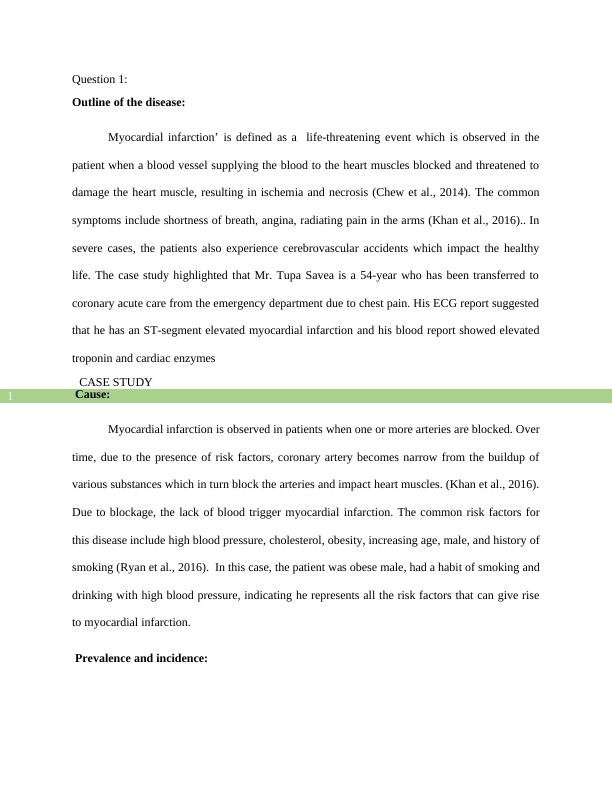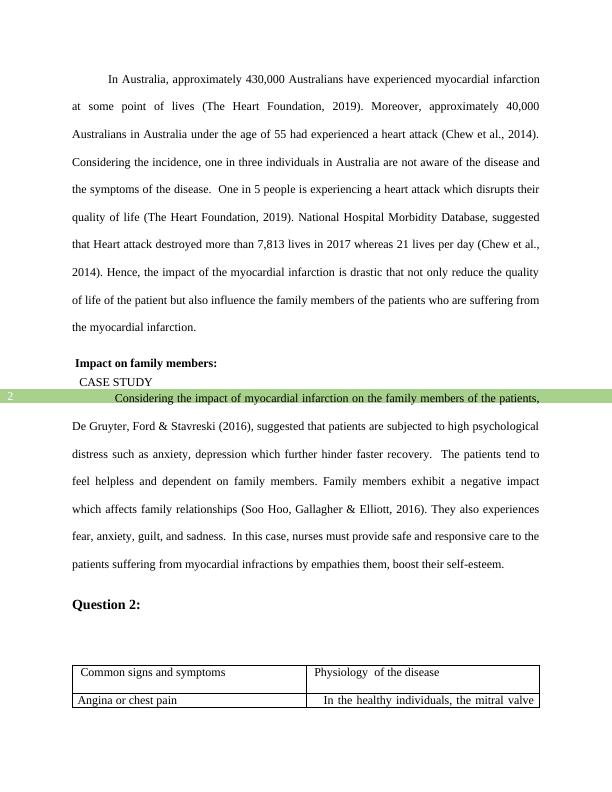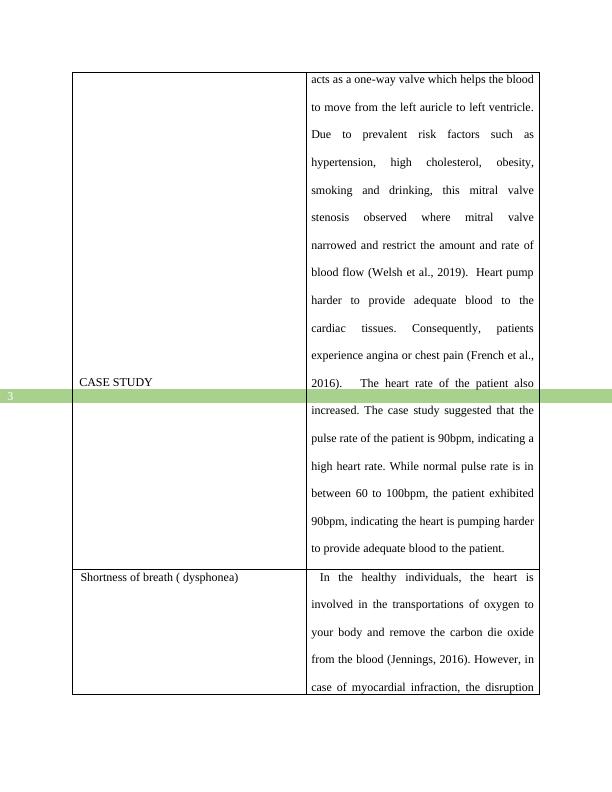Outline of the Disease Case Study 2022
Added on 2022-10-15
15 Pages2926 Words41 Views
Running head: CASE STUDY
CASE STUDY
Name of the student:
Name of the university:
Author note
CASE STUDY
Name of the student:
Name of the university:
Author note

CASE STUDY
1
Question 1:
Outline of the disease:
Myocardial infarction’ is defined as a life-threatening event which is observed in the
patient when a blood vessel supplying the blood to the heart muscles blocked and threatened to
damage the heart muscle, resulting in ischemia and necrosis (Chew et al., 2014). The common
symptoms include shortness of breath, angina, radiating pain in the arms (Khan et al., 2016).. In
severe cases, the patients also experience cerebrovascular accidents which impact the healthy
life. The case study highlighted that Mr. Tupa Savea is a 54-year who has been transferred to
coronary acute care from the emergency department due to chest pain. His ECG report suggested
that he has an ST-segment elevated myocardial infarction and his blood report showed elevated
troponin and cardiac enzymes
Cause:
Myocardial infarction is observed in patients when one or more arteries are blocked. Over
time, due to the presence of risk factors, coronary artery becomes narrow from the buildup of
various substances which in turn block the arteries and impact heart muscles. (Khan et al., 2016).
Due to blockage, the lack of blood trigger myocardial infarction. The common risk factors for
this disease include high blood pressure, cholesterol, obesity, increasing age, male, and history of
smoking (Ryan et al., 2016). In this case, the patient was obese male, had a habit of smoking and
drinking with high blood pressure, indicating he represents all the risk factors that can give rise
to myocardial infarction.
Prevalence and incidence:
1
Question 1:
Outline of the disease:
Myocardial infarction’ is defined as a life-threatening event which is observed in the
patient when a blood vessel supplying the blood to the heart muscles blocked and threatened to
damage the heart muscle, resulting in ischemia and necrosis (Chew et al., 2014). The common
symptoms include shortness of breath, angina, radiating pain in the arms (Khan et al., 2016).. In
severe cases, the patients also experience cerebrovascular accidents which impact the healthy
life. The case study highlighted that Mr. Tupa Savea is a 54-year who has been transferred to
coronary acute care from the emergency department due to chest pain. His ECG report suggested
that he has an ST-segment elevated myocardial infarction and his blood report showed elevated
troponin and cardiac enzymes
Cause:
Myocardial infarction is observed in patients when one or more arteries are blocked. Over
time, due to the presence of risk factors, coronary artery becomes narrow from the buildup of
various substances which in turn block the arteries and impact heart muscles. (Khan et al., 2016).
Due to blockage, the lack of blood trigger myocardial infarction. The common risk factors for
this disease include high blood pressure, cholesterol, obesity, increasing age, male, and history of
smoking (Ryan et al., 2016). In this case, the patient was obese male, had a habit of smoking and
drinking with high blood pressure, indicating he represents all the risk factors that can give rise
to myocardial infarction.
Prevalence and incidence:

CASE STUDY
2
In Australia, approximately 430,000 Australians have experienced myocardial infarction
at some point of lives (The Heart Foundation, 2019). Moreover, approximately 40,000
Australians in Australia under the age of 55 had experienced a heart attack (Chew et al., 2014).
Considering the incidence, one in three individuals in Australia are not aware of the disease and
the symptoms of the disease. One in 5 people is experiencing a heart attack which disrupts their
quality of life (The Heart Foundation, 2019). National Hospital Morbidity Database, suggested
that Heart attack destroyed more than 7,813 lives in 2017 whereas 21 lives per day (Chew et al.,
2014). Hence, the impact of the myocardial infarction is drastic that not only reduce the quality
of life of the patient but also influence the family members of the patients who are suffering from
the myocardial infarction.
Impact on family members:
Considering the impact of myocardial infarction on the family members of the patients,
De Gruyter, Ford & Stavreski (2016), suggested that patients are subjected to high psychological
distress such as anxiety, depression which further hinder faster recovery. The patients tend to
feel helpless and dependent on family members. Family members exhibit a negative impact
which affects family relationships (Soo Hoo, Gallagher & Elliott, 2016). They also experiences
fear, anxiety, guilt, and sadness. In this case, nurses must provide safe and responsive care to the
patients suffering from myocardial infractions by empathies them, boost their self-esteem.
Question 2:
Common signs and symptoms Physiology of the disease
Angina or chest pain In the healthy individuals, the mitral valve
2
In Australia, approximately 430,000 Australians have experienced myocardial infarction
at some point of lives (The Heart Foundation, 2019). Moreover, approximately 40,000
Australians in Australia under the age of 55 had experienced a heart attack (Chew et al., 2014).
Considering the incidence, one in three individuals in Australia are not aware of the disease and
the symptoms of the disease. One in 5 people is experiencing a heart attack which disrupts their
quality of life (The Heart Foundation, 2019). National Hospital Morbidity Database, suggested
that Heart attack destroyed more than 7,813 lives in 2017 whereas 21 lives per day (Chew et al.,
2014). Hence, the impact of the myocardial infarction is drastic that not only reduce the quality
of life of the patient but also influence the family members of the patients who are suffering from
the myocardial infarction.
Impact on family members:
Considering the impact of myocardial infarction on the family members of the patients,
De Gruyter, Ford & Stavreski (2016), suggested that patients are subjected to high psychological
distress such as anxiety, depression which further hinder faster recovery. The patients tend to
feel helpless and dependent on family members. Family members exhibit a negative impact
which affects family relationships (Soo Hoo, Gallagher & Elliott, 2016). They also experiences
fear, anxiety, guilt, and sadness. In this case, nurses must provide safe and responsive care to the
patients suffering from myocardial infractions by empathies them, boost their self-esteem.
Question 2:
Common signs and symptoms Physiology of the disease
Angina or chest pain In the healthy individuals, the mitral valve

CASE STUDY
3
acts as a one-way valve which helps the blood
to move from the left auricle to left ventricle.
Due to prevalent risk factors such as
hypertension, high cholesterol, obesity,
smoking and drinking, this mitral valve
stenosis observed where mitral valve
narrowed and restrict the amount and rate of
blood flow (Welsh et al., 2019). Heart pump
harder to provide adequate blood to the
cardiac tissues. Consequently, patients
experience angina or chest pain (French et al.,
2016). The heart rate of the patient also
increased. The case study suggested that the
pulse rate of the patient is 90bpm, indicating a
high heart rate. While normal pulse rate is in
between 60 to 100bpm, the patient exhibited
90bpm, indicating the heart is pumping harder
to provide adequate blood to the patient.
Shortness of breath ( dysphonea) In the healthy individuals, the heart is
involved in the transportations of oxygen to
your body and remove the carbon die oxide
from the blood (Jennings, 2016). However, in
case of myocardial infraction, the disruption
3
acts as a one-way valve which helps the blood
to move from the left auricle to left ventricle.
Due to prevalent risk factors such as
hypertension, high cholesterol, obesity,
smoking and drinking, this mitral valve
stenosis observed where mitral valve
narrowed and restrict the amount and rate of
blood flow (Welsh et al., 2019). Heart pump
harder to provide adequate blood to the
cardiac tissues. Consequently, patients
experience angina or chest pain (French et al.,
2016). The heart rate of the patient also
increased. The case study suggested that the
pulse rate of the patient is 90bpm, indicating a
high heart rate. While normal pulse rate is in
between 60 to 100bpm, the patient exhibited
90bpm, indicating the heart is pumping harder
to provide adequate blood to the patient.
Shortness of breath ( dysphonea) In the healthy individuals, the heart is
involved in the transportations of oxygen to
your body and remove the carbon die oxide
from the blood (Jennings, 2016). However, in
case of myocardial infraction, the disruption

End of preview
Want to access all the pages? Upload your documents or become a member.
Related Documents
Case Study on Cardiovascularlg...
|10
|2204
|31
Clinical Case Study of Myocardial Infarctionlg...
|12
|4148
|194
Nursing Assignment: Myocardial Infarction and Nursing Carelg...
|12
|3201
|2
Clinical Case of Acute Myocardial Infarctionlg...
|11
|3455
|54
ACUTE CORONARY SYNDROMElg...
|12
|3546
|1
Congestive Heart Failure Case Studylg...
|10
|2805
|129
